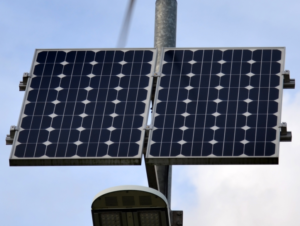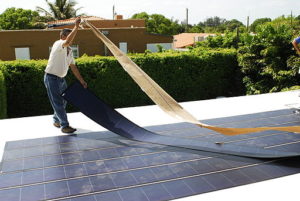Our solar panel guide will introduce you the solar panels you may want to consider for your home. We’ll look at the pros and cons of three different solar panel types you are likely to encounter. Do you know which equipment offers the highest quality? Which is the most affordable? Or which is the easiest to install? Let’s find out as we consider each of these options for your home solar power system.
- Monocrystalline Solar Panel Guide
- Polycrystalline Solar Panel Guide
- Thin-Film Solar Solar Panel Guide
Monocrystalline Solar Panel Guide
Efficiency
 Are you looking for the top quality in solar? Monocrystalline solar panels are your best bet. They are the highest efficiency solar panel, by area, currently available to consumers. They can potentially offer up to 20% efficiency per module.[1] EPA, 2013 As you would expect, this quality also means they are more expensive than other solar panel types. But many feel the expense is worth it for panels with a long lifespan, reliability and low-maintenance, and efficiency. These panels utilize every bit of sunshine!
Are you looking for the top quality in solar? Monocrystalline solar panels are your best bet. They are the highest efficiency solar panel, by area, currently available to consumers. They can potentially offer up to 20% efficiency per module.[1] EPA, 2013 As you would expect, this quality also means they are more expensive than other solar panel types. But many feel the expense is worth it for panels with a long lifespan, reliability and low-maintenance, and efficiency. These panels utilize every bit of sunshine!
You’ll pay a higher price per panel for this premium product. But monocrystalline panels may actually be a smart investment if you need to make the most of your roof area and install fewer panels. As explained in our solar roof guide, the size and strength of your roof determines its suitability for solar panels. But not every kind of solar panel is equally suitable for every roof!
Characteristics
Both monocrystalline and polycrystalline panels (which we’ll look at in a moment) are powered by silicon. The silicon is processed on a chemical level and functions as a semiconductor in the photovoltaic process. (“Photovoltaic” simply means an electric current is made from light. All solar power technology is photovoltaic.) But monocrystalline are the most efficient panels on the market. And that’s because they make the most powerful use of crystalline silicon.
Lifespan
Every kind of solar panel will degrade over time from wear and tear. Extreme seasonal temperatures, heavy wind, snow, and weather contribute to this wear. But under the mildest of conditions, it may be possible for one solar panel installation to power the majority of home’s energy for up to four decades! The added upfront expense of installing premium quality panels can mean a great return on your solar investment, in the long run. Exactly how much greater the expense might be will vary between solar installers and regions.
Ultimately, monocrystalline solar panels might be the right choice in either of two scenarios. First: if your roof is on the smaller side, you can make the most of the space you have with high-efficiency panels. Second: if your roof size is fine but you can afford to make a bigger investment, it’ll pay off to have top quality equipment that lasts you for many years to come.
Polycrystalline Solar Panel Guide
Efficiency
Our next panels, polycrystalline, peak around 17% efficiency. They use similar technology to the closely related monocrystalline, but they are a little less expensive and a little less efficient. Both solar panel types use semiconductors made of silicon. So what accounts for these differences?
Characteristics
![]() Monocrystalline provides maximal efficiency in power conversion. That’s because monocrystalline cells are cut from one large crystal of silicon. (Hence the name: “mono” means “one.”) But these whole silicon crystals are a relatively costly element in the supply chain.
Monocrystalline provides maximal efficiency in power conversion. That’s because monocrystalline cells are cut from one large crystal of silicon. (Hence the name: “mono” means “one.”) But these whole silicon crystals are a relatively costly element in the supply chain.
Polycrystalline cells, on the other hand, make use of smaller pieces of silicon. (This makes since if you know that “poly” means “many”!) These fragments of crystals are melted and molded together, forming a fused solid. This solid can then be sliced into thin pieces for use in solar panels. You could almost think of monocrystalline as solid hardwood, and polycrystalline as plywood.
Lifespan
Polycrystalline panels are good quality and generally quite reliable. Warranties typically guarantee these panels will continue to provide 80% or more of their power producing capacity for 25 years.
In summary, these panels may be the perfect fit if you are looking to get good-quality solar panels installed as soon as possible for an accessible price.
Thin-Film Solar Panel Guide
Efficiency
The final solar panel type we’ll look at is thin-film solar panels. These average only about 11% efficiency per module. That’s a lot lower efficiency than the silicon-based panels we’ve just looked at! Thin-film won’t be the right choice if you need to make the most of every square foot of your roof to generate maximum energy.
Understandably, crystalline-silicon panels such as monocrystalline and polycrystalline panels have accounted for 80%-95% of the panels shipped for decades![2]NREL, 2016 Thin-film is definitely the less common choice. So, why would anyone want to use thin-film? Well, it actually has benefits that are important in certain situations: low cost, flexibility, and light weight.[3]US Energy Information Administration, 2017.
Characteristics
 Thin-film panels are actually quite flexible, bending and flexing similarly to a carpet. Unlike the silicon-based panels that are very rigid, thin-film panels can be stored in rolls! This feature can make installation and maintenance easier and quicker, leading to lower costs when it comes to labor.
Thin-film panels are actually quite flexible, bending and flexing similarly to a carpet. Unlike the silicon-based panels that are very rigid, thin-film panels can be stored in rolls! This feature can make installation and maintenance easier and quicker, leading to lower costs when it comes to labor.
These panels are also uniquely light-weight. And some thin-film panels are designed to appear similar to traditional roof materials, allowing them to camouflage with an existing roof. If you have an unusually designed roof, or would prefer a less intrusive visual impact on your roof, thin-film might be appealing. Depending on your needs and priorities, these advantages could outweigh need for solar panel efficiency.
Lifespan
As you might expect, thin-film doesn’t last as long as the crystalline-silicon panels. But if weather conditions aren’t too harsh, these thin-film panels have the potential to last for 20 years. Lifespan is especially important for homeowners who are looking to get 25-40 years from their home solar, and they’ll likely opt for silicon panels. But if you might replace your roof in 20 years or less anyway, it won’t make sense to pay a premium for solar panels that will outlive your roof!
In conclusion, thin-film panels might be right for you if you want flexible, lightweight panels that can camouflage with your roof; or if you can forego maximum efficiency and lifespan in exchange for a better price. The decision to use thin-film can work alongside other cost-saving strategies to keep solar installation affordable for you.
(Images: Monocrystalline solar panel by Lamiot; Polycrystalline silicon by Hi-Res Images of Chemical Elements; Thin Film Flexible Solar PV Installation by Fieldsken Ken Fields. All images licensed under CC BY-SA 3.0.)
References
